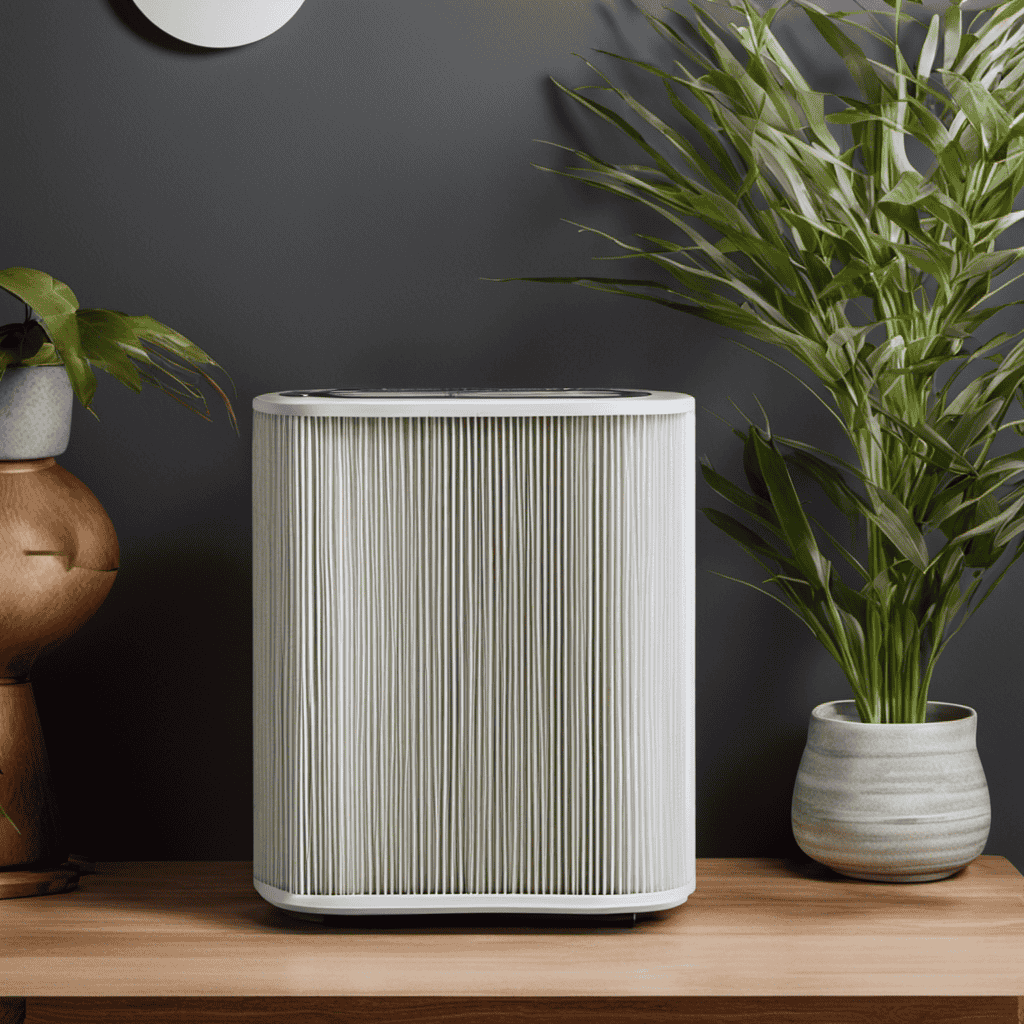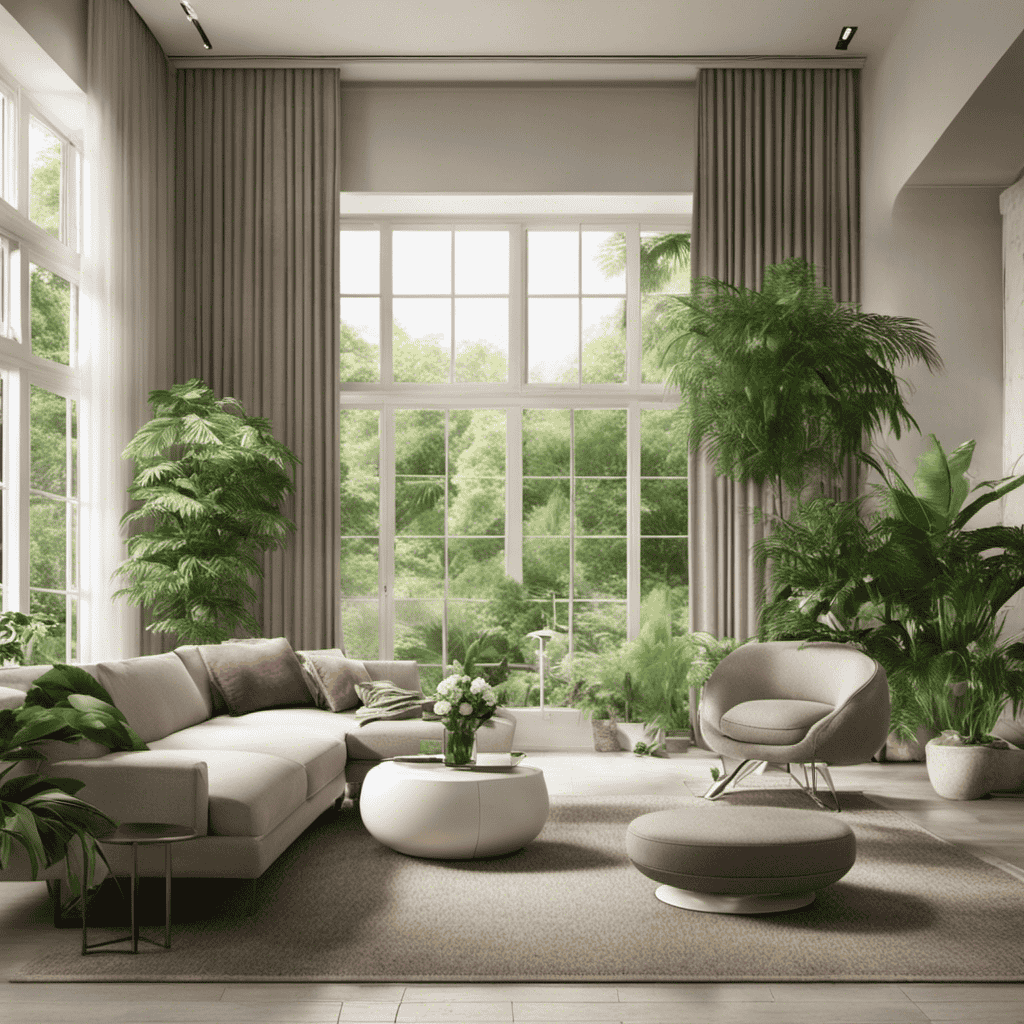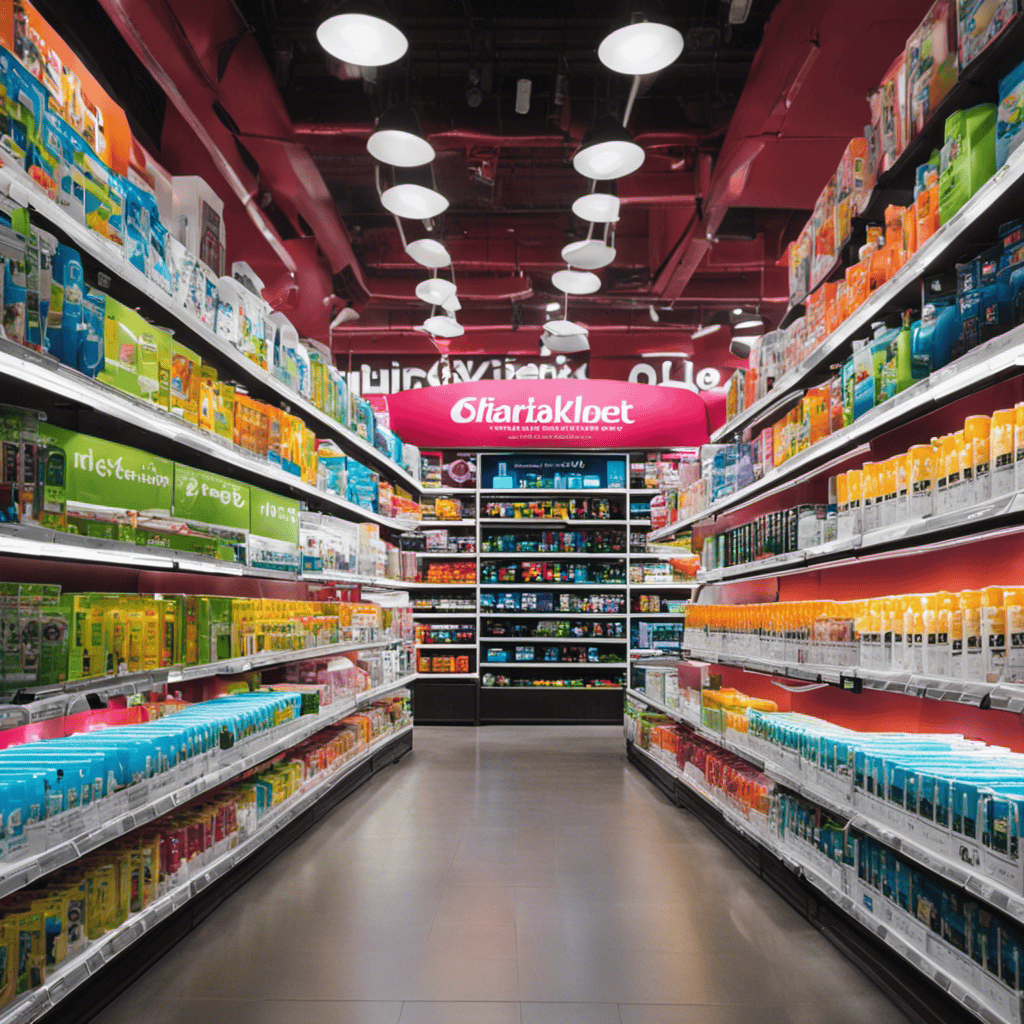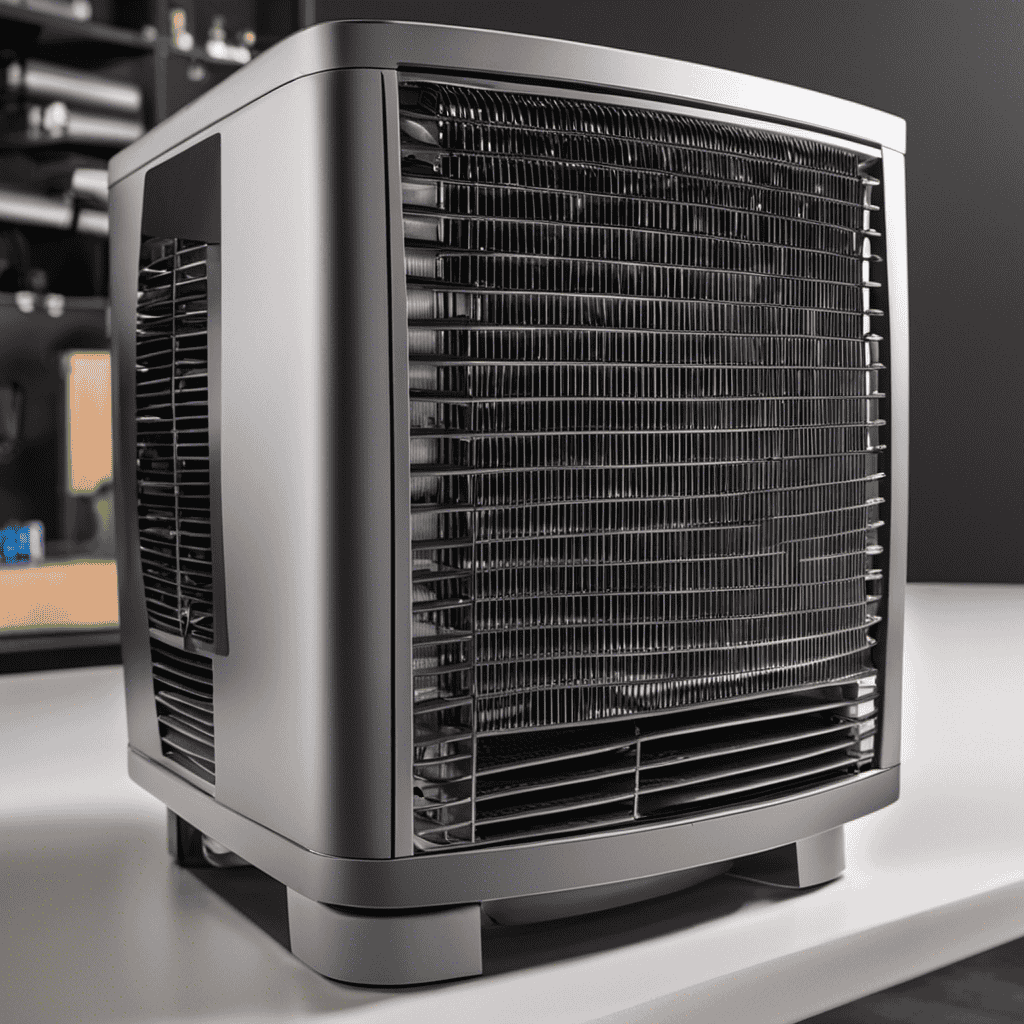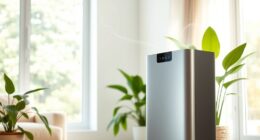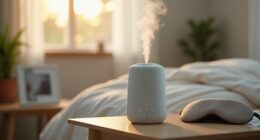As I meticulously position the new air filter into my air purifier, I’m already anticipating the crisp, purified air that’s soon to envelop me.
In this article, I will guide you through the step-by-step process of how to put in an air filter in your air purifier.
With a variety of air filters to choose from and proper installation techniques, you’ll be able to enjoy a healthier and cleaner environment in no time.
So, let’s get started and ensure the air in your home is pure and pollutant-free.
Key Takeaways
- Air filter ratings determine effectiveness, with HEPA filters capturing 99.97% of particles.
- Activated carbon filters are effective at removing odors and gases.
- Regular maintenance, including cleaning and proper filter replacement, improves the performance and longevity of the air purifier.
- It is important to ensure the correct filter size and type for proper filtration and compatibility with the air purifier.
Types of Air Filters for Air Purifiers
There are several types of air filters you can choose from for your air purifier. Air filter ratings play a crucial role in determining the effectiveness of the filter. The higher the rating, the better it is at capturing small particles like dust, pollen, and pet dander.
HEPA (High-Efficiency Particulate Air) filters are considered the gold standard, capable of trapping 99.97% of particles as small as 0.3 microns.
Activated carbon filters are great for removing odors, chemicals, and gases from the air.
Washable filters are reusable and cost-effective, but they may not be as efficient as other types.
Regular filter maintenance is essential to keep your air purifier functioning optimally. It ensures that the filter remains clean and free from debris, improving its overall performance and prolonging its lifespan.
Choosing the Right Air Filter for Your Air Purifier
When choosing the right filter for your purifier, it’s important to consider the specific needs of your air quality. Different air filters have varying levels of efficiency in removing pollutants from the air. Here are five factors to consider when selecting an air filter for your air purifier:
-
Filter Efficiency: Look for a filter with a high efficiency rating, such as HEPA filters, which can remove up to 99.97% of particles as small as 0.3 microns.
-
Filter Type: Consider the specific pollutants you want to target. Activated carbon filters are effective at removing odors and chemicals, while antimicrobial filters can help with bacteria and viruses.
-
Filter Lifespan: Some filters need to be replaced more frequently than others. Check the manufacturer’s recommendations to ensure you can maintain the filter’s efficiency.
-
Filter Size: Make sure the filter is the right size for your air purifier. Using the wrong size filter can result in poor air filtration.
-
Air Purifier Compatibility: Ensure the filter is compatible with your specific air purifier model to ensure proper functioning.
Using an air purifier with an efficient air filter can provide numerous benefits, including improved indoor air quality, reduced allergens, and a healthier living environment.
Preparing Your Air Purifier for Filter Installation
Before installing the filter, make sure your air purifier is properly prepared.
First, ensure that the power is turned off and the unit is unplugged.
Then, locate the filter compartment on your air purifier. Open it carefully, following the manufacturer’s instructions.
Remove any existing filter and dispose of it properly.
Next, clean the interior of the purifier using a soft, dry cloth to remove any dust or debris.
Once the purifier is clean, inspect the filter you have chosen for installation. Make sure it is the correct size and type recommended for your specific model.
Carefully insert the new filter into the compartment, following the directional arrows or instructions provided.
Close the compartment securely and plug the unit back in.
Now, your air purifier is ready to effectively filter the air in your space.
Removing the Old Air Filter From Your Air Purifier
When it comes to removing the old air filter from your air purifier, it is crucial to follow proper filter removal techniques to ensure a smooth transition.
Using the right tools can make the removal process much easier and more efficient, saving you time and frustration.
Once the old filter is successfully removed, you can then proceed with the filter replacement steps to ensure the continued functionality and effectiveness of your air purifier.
Proper Filter Removal
To properly remove the filter, make sure you’ve unplugged the air purifier.
Removing the filter from an air purifier is a simple process, but it is important to do it correctly to avoid any damage or contamination. Here are the steps to properly remove the filter:
- Locate the filter compartment on your air purifier.
- Open the compartment door or remove the cover to access the filter.
- Carefully pull out the old filter, making sure not to touch the dirty surface.
- Dispose of the old filter according to the manufacturer’s instructions. Some filters can be recycled, while others need to be thrown away.
- If you encounter any difficulties during the removal process, consult the user manual or contact customer support for troubleshooting assistance.
By following these steps, you can safely remove the old filter and prepare your air purifier for a new one.
Proper filter disposal is essential for maintaining the efficiency and effectiveness of your air purifier.
Tools for Easy Removal
If you want an easy removal process, make sure you have the necessary tools on hand. The screwdriver will be used to remove any screws or fasteners that secure the filter compartment. The gloves will protect your hands from dust and contaminants, ensuring a hygienic process. Additionally, the clean cloth will come in handy for wiping down the filter compartment before installing the new filter. By having these tools readily available, you can easily perform the necessary steps for easy installation and filter maintenance.
Once you have successfully removed the old filter, you can proceed to the next section to learn about the filter replacement steps.
Filter Replacement Steps
You’ll want to start by removing the old filter from the compartment. This is an important step in filter maintenance and is crucial for troubleshooting air filters.
Here are the steps to follow when replacing your air filter:
- Open the air purifier’s compartment by removing the front cover or accessing the filter panel.
- Take note of how the old filter is positioned before removing it. This will help ensure proper installation of the new filter.
- Carefully remove the old filter from the compartment, making sure not to damage it or leave any debris behind.
- Dispose of the old filter properly, following any specific instructions provided by the manufacturer.
- Take the new filter out of its packaging and insert it into the compartment, aligning it correctly according to the previous filter’s position.
Properly Inserting the New Air Filter Into Your Air Purifier
When it comes to filter insertion techniques for air purifiers, there are a few key points to keep in mind.
First and foremost, always refer to the manufacturer’s instructions for guidance on the specific model you are working with.
Secondly, make sure to handle the new filter with care, avoiding any contact with dirt or debris.
Lastly, ensure that the filter is properly aligned and securely inserted into the air purifier, allowing for optimal air flow and filtration efficiency.
As for maintenance tips, regular filter replacement is crucial to ensure the continued effectiveness of your air purifier.
Additionally, it is important to clean or replace pre-filters as recommended to prevent the buildup of larger particles and extend the lifespan of the main filter.
Filter Insertion Techniques
To insert the filter properly, make sure you follow the instructions provided by the manufacturer. Improper filter insertion can lead to reduced air purification efficiency and potential damage to the air purifier. Here are some filter insertion techniques to ensure optimal performance:
- Ensure the air purifier is turned off and unplugged before starting the filter insertion process.
- Locate the filter compartment, usually found at the rear or top of the air purifier.
- Remove the old filter by gently pulling it out or unlocking the compartment.
- Align the new filter correctly, ensuring that the arrows or labels on the filter match the corresponding markings on the filter compartment.
- Carefully slide the filter into the compartment, making sure it fits securely and snugly.
By following these filter insertion techniques, you can maintain the efficiency of your air purifier and troubleshoot any issues related to filter maintenance.
Now, let’s move on to some maintenance tips for filters.
Maintenance Tips for Filters
Make sure you regularly clean the filters to ensure optimal performance and prevent any build-up of dust or debris. Cleaning techniques for air purifier filters may vary depending on the type of filter you have. Here are some troubleshooting tips and cleaning techniques to keep your filters in top condition:
| Filter Type | Cleaning Technique |
|---|---|
| HEPA | Vacuum with a brush attachment or rinse under water (if washable) |
| Carbon | Replace with a new filter |
| Pre-filter | Vacuum or rinse under water (if washable) |
When cleaning your filters, always refer to the manufacturer’s instructions for specific cleaning guidelines. It is recommended to clean or replace filters every 3-6 months, or as instructed by the manufacturer. Regular maintenance of your filters will ensure efficient air purification and prolong the lifespan of your air purifier. Troubleshooting tip: If your air purifier is not working properly, check if the filters are clean and properly inserted.
Securing the Air Filter in Your Air Purifier
Once you’ve chosen the correct air filter for your air purifier, it’s important to securely fasten it in place. Properly securing the air filter ensures that it functions optimally and prevents any air leakage or bypass.
To securely fasten the air filter in your air purifier, follow these steps:
- Ensure that the air purifier is turned off and unplugged before starting the installation process.
- Carefully remove the old air filter from the air purifier, taking note of its orientation.
- Align the new air filter in the correct direction, making sure it fits snugly into the designated slot.
- Double-check that the air filter is securely positioned and there are no gaps or loose ends.
- Once the air filter is properly placed, close the air purifier’s cover or door tightly to seal it shut.
By securely fastening the air filter in your air purifier, you can ensure efficient air filtration and maintain the overall performance of your device.
Regularly check and replace the air filter as recommended for proper air filter maintenance.
Testing and Maintaining Your Air Filter in the Air Purifier
Now that we have successfully secured the air filter in our air purifier, it’s time to move on to testing and maintaining the filter. Regular maintenance is crucial to ensure optimal performance and longevity of the air purifier. Let’s take a look at some cleaning techniques and troubleshooting common filter issues.
| Cleaning Techniques | Troubleshooting Common Filter Issues |
|---|---|
| Vacuuming: Use a brush attachment on your vacuum cleaner to gently remove dust and debris from the filter. | Reduced airflow: If you notice a decrease in airflow, it could be due to a clogged filter. Clean or replace the filter as necessary. |
| Washing: Some air filters can be washed with water and mild detergent. Follow the manufacturer’s instructions for proper cleaning. | Strange odors: If the air coming from the purifier has a foul smell, it may indicate a dirty or contaminated filter. Clean or replace it immediately. |
| Dry Cleaning: Use a soft cloth or brush to gently remove surface dust from the filter. Avoid using water or liquid cleaners. | Filter lifespan: Keep track of the filter’s lifespan and replace it according to the manufacturer’s recommendations. Using a filter beyond its recommended lifespan can affect the purifier’s efficiency. |
Frequently Asked Questions
How Effective Are Air Filters in Improving Indoor Air Quality?
Air filters are highly effective in improving indoor air quality. They trap and remove harmful particles, such as dust, pollen, and pet dander, providing numerous benefits, including reduced allergies and respiratory issues.
Can I Use a Different Brand of Air Filter in My Air Purifier?
Certainly, using a different brand of air filter in your air purifier is possible, but it’s important to consider air filter compatibility. Check the specifications and guidelines provided by the manufacturer for optimal performance and efficiency.
How Often Should I Replace the Air Filter in My Air Purifier?
I replace the air filter in my air purifier every 3-6 months, depending on the manufacturer’s recommendations and the air quality in my home. Regular air filter maintenance is essential for optimal performance.
Are There Any Special Considerations for Installing an Air Filter in a Portable Air Purifier?
There are several important considerations when installing an air filter in a portable air purifier. The installation process must be followed correctly to ensure proper functioning and optimal air purification performance.
Can I Clean and Reuse the Air Filter in My Air Purifier?
I can clean and reuse the air filter in my air purifier. It’s important to follow the manufacturer’s instructions for cleaning. Regular cleaning helps maintain the filter’s effectiveness in removing pollutants from the air.
Conclusion
In conclusion, installing an air filter in your air purifier is a simple yet crucial task to ensure clean and fresh air in your surroundings. By carefully selecting the appropriate air filter for your specific needs and following the proper steps for installation, you can effectively remove harmful pollutants from your indoor air.
Just like a knight securing his armor before battle, securing the air filter in your air purifier shields you from the invisible enemies that lurk in the air, creating a safe and healthy environment for you and your loved ones.
